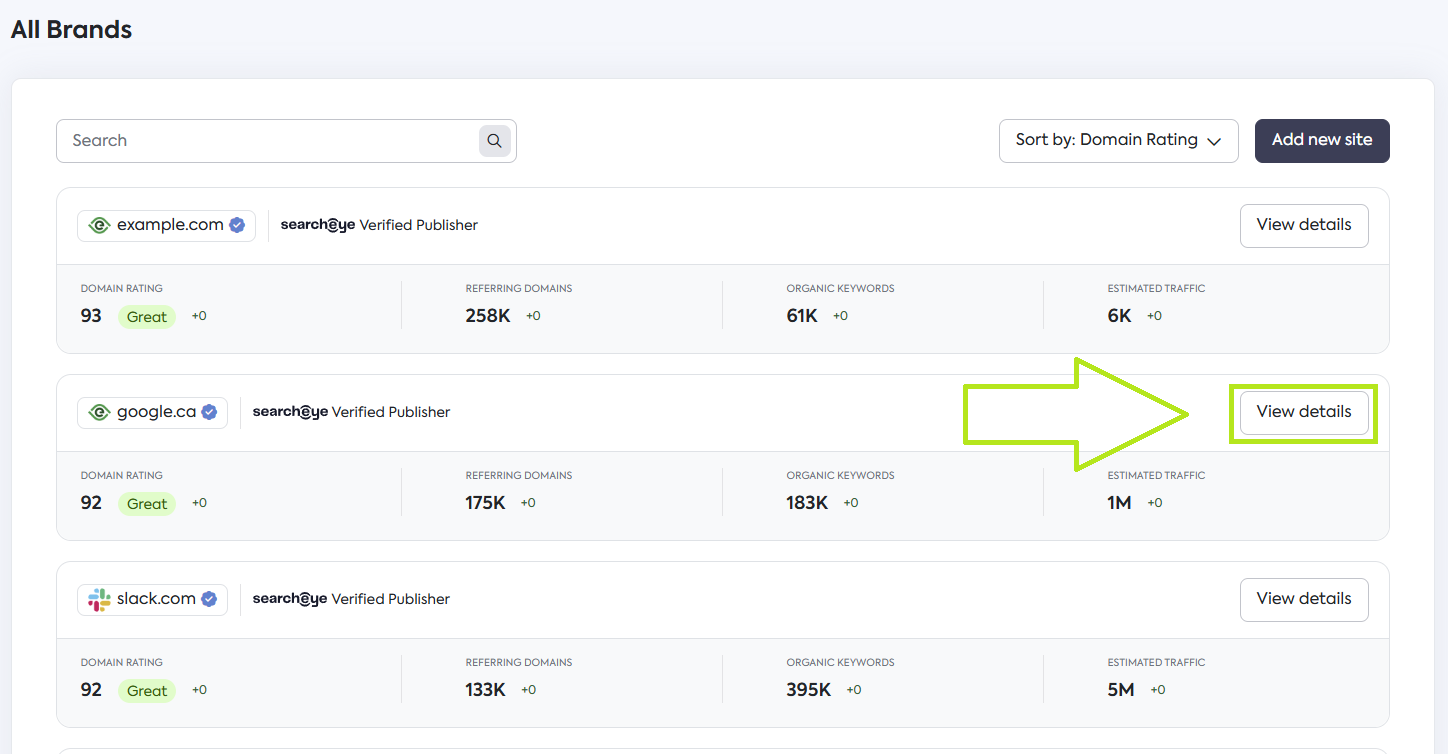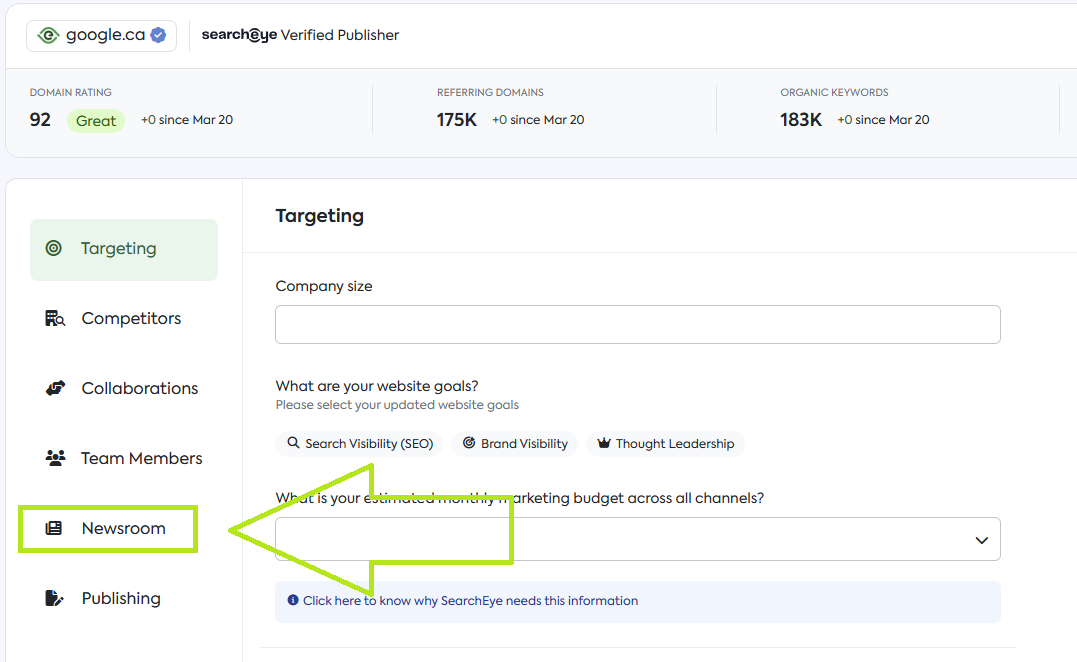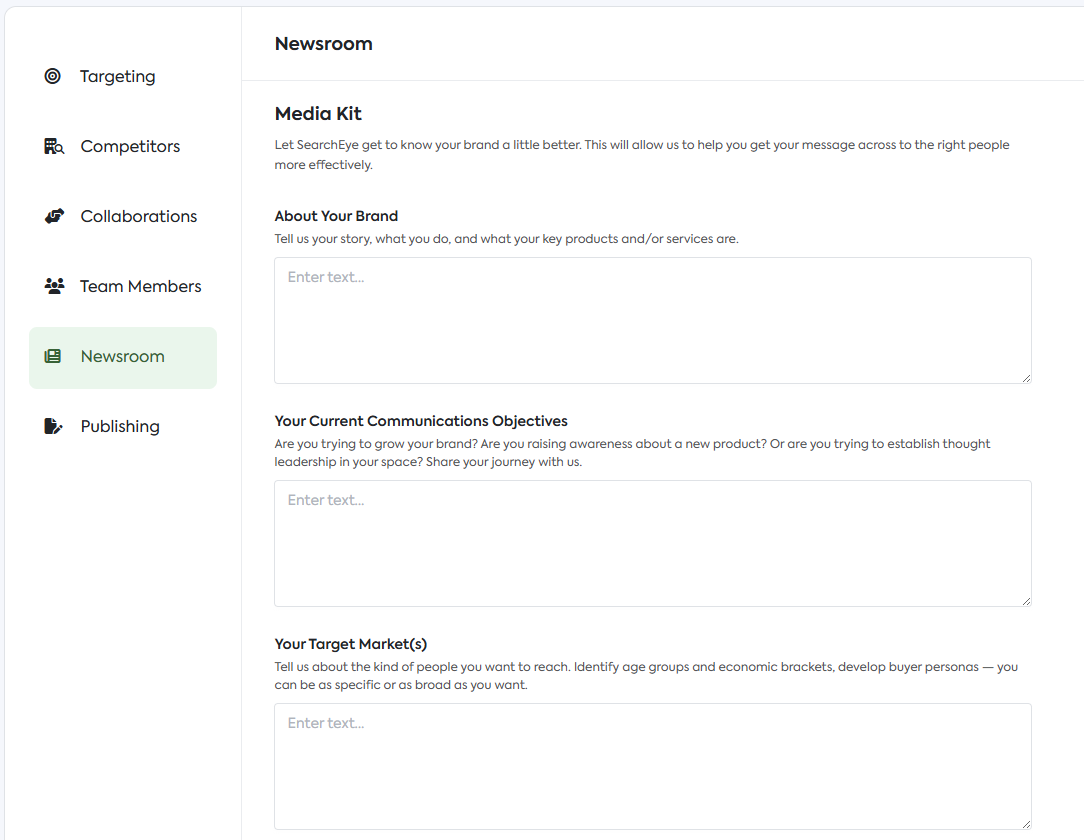The Newsroom for Brands
Learn how to leverage SearchEye’s Media Kit to create targeted, brand-aligned content for successful publisher collaborations.
SearchEye's Media Kit
The Media Kit in SearchEye’s Newsroom is designed to comprehensively understand your brand. This information is pivotal for crafting tailored pitches that align perfectly with both your brand goals and publisher editorial guidelines.
Accessing Your Media Kit
To access your website's Media Kit, here are the following steps:
From the Brand dashboard click on All Brands to view all your listed websites.
On your selected website, click on View details.
From the website details page, click on Newsroom.
Provided you have followed the steps correctly, you should be able to see the Media Kit immediately.
How to Use The Media Kit
The Media Kit consists of several sections, which include:
About your Brand
Your Current Communications Objectives
Your Target Market(s)
Target Promotional Pages
Sample Content
What Kind of Content Works for You?
Here’s how to effectively utilize each section, complete with examples and educational insights.
About Your Brand
This section introduces your brand’s narrative, values, and unique offerings to publishers. It establishes a solid understanding of your brand identity, enabling publishers to create content that genuinely reflects and promotes your brand values and vision.
What to Include:
Brand Story: Narrate the origin, evolution, and milestones of your brand. Example: "ABC Tech was founded in 2010 with a vision to integrate technology into everyday living, starting from a small workshop in Silicon Valley."
Mission and Vision: Clearly articulate your driving force and future aspirations. Example: "Our mission is to innovate daily tasks through intelligent technology, aiming to make every home smart by 2030."
Key Products/Services: Highlight your primary offerings and any niche markets you serve. Example: "We specialize in smart home ecosystems, including automated lighting, security, and climate control systems."
Unique Selling Proposition (USP): Describe what sets your brand apart. Example: "Our products adapt to user behaviors over time, offering unparalleled personalization."
Your Current Communications Objectives
This section defines the strategic intent behind your communication efforts. It directs the creation of content that aligns precisely with your current marketing strategies, ensuring relevancy and effectiveness.
What to Include:
Growth Goals: Specify measurable objectives for brand awareness or market expansion. Example: "Objective to increase market share by 20% among millennials within the next year through targeted digital campaigns."
Product Launches: Mention any upcoming products and the promotional goals associated with them. Example: "Launching our Gen2 SmartLamp in Q3, aiming for feature articles in top tech blogs."
Thought Leadership: Outline aspirations to establish authority in your industry. Example: "Plan to position our CEO as a thought leader on sustainable living through speaking engagements and expert commentary."
Your Target Market(s)
This section pinpoints exactly who your content should reach. It ensures content is crafted to engage and resonate with the intended demographic, enhancing the effectiveness of communication.
What to Include:
Demographics: Describe the age, location, income level, and other demographic details of your target audience. Example: "Our core audience includes urban professionals aged between 25-40 years with a keen interest in technology."
Psychographics: Share insights into the behaviors, values, and lifestyle preferences of your audience. Example: "Our customers prioritize efficiency, innovation, and eco-friendliness in their purchasing decisions."
Buyer Personas: Create detailed profiles that represent segments of your audience. Example: "Persona Example: Tech-savvy Tim, a 35-year-old urban architect, who looks for ways to integrate technology into his sustainable lifestyle."
Market Segments: Identify specific groups within your target market that you particularly wish to engage. Example: "Focusing on environmentally conscious consumers looking to reduce their carbon footprint."
Target Promotional Pages
This section allows you to specify key URLs that you want to highlight in your media outreach. These pages should align with your marketing objectives and serve as valuable destinations for your target audience.
What to Include:
Product Pages: Direct traffic to your flagship products or new launches.
Landing Pages: Promote specific campaigns or lead-generation funnels.
Blog Posts: Highlight thought leadership, case studies, or industry insights.
Service Pages: Showcase your core offerings and value propositions.
Example URLs:
Product Page: https://yourbrand.com/smartlamp-gen2
Landing Page: https://yourbrand.com/early-access
Blog Post: https://yourbrand.com/blog/future-of-home-automation
Service Page: https://yourbrand.com/smart-home-solutions
Sample Content
This section provides a framework for the type of content that aligns with your brand voice and goals. It helps set expectations for both the style and substance of the content, ensuring it not only aligns with your branding but also effectively engages your target audience.
What to Include:
Topic Suggestions: Propose potential content topics that align with your brand and audience interests. Example: "Exploring the Future of Home Automation"
Article Briefs: Offer a concise outline of what each article could cover. Example: "A feature on how integrating smart devices can drastically reduce household energy consumption."
Integration Examples: Demonstrate how your products or services can be naturally woven into the content. Example: "Include a case study of a family using our Smart Thermostat to lower their energy bills."
Previous Successful Pieces: If applicable, share links or summaries of content that has previously performed well. Example: "Our article on ‘Smart Security Systems for Urban Dwellers’ received over 10,000 shares last month."
By providing detailed, targeted information in your Media Kit, you empower SearchEye to create pitches that are not only tailored to your brand's needs but also resonate deeply with both publishers and your audience, ensuring successful outcomes from each campaign.
What Kind of Content Works for You?
This section helps you define the specific content formats that align with your campaign goals. By choosing your preferred formats, you guide publishers on the best way to feature your brand—whether it’s a brief, authoritative mention in an educational article or a full, in-depth brand story.
This ensures the final publication is a format that serves your strategic objectives.
What to Specify:
Informative Content: Select these formats if your goal is to gain mentions in educational, insightful, or easily digestible articles. These are ideal for placing expert quotes, contextual links, and brief brand highlights.
Example Formats:
How-to Articles: "How to Set Up Your First Smart Home in Under an Hour."
Guides: "The Ultimate Buyer's Guide to Smart Lighting Systems."
Listicles / Roundups: "7 Smart Home Gadgets That Can Lower Your Energy Bill."
Q&A Articles: "A Q&A with an expert on the benefits of home security automation."
Feature & Brand-Centric Content: Request these formats when your objective is a deeper dive into your brand, products, or leadership. These are reserved for full-feature stories, product showcases, and establishing authority.
Example Formats:
Interviews: "An in-depth interview with our CEO about the future of sustainable technology."
Product Reviews: "A hands-on review of our new Gen2 SmartLamp."
Product Comparisons: "A comparative look at our smart home ecosystem versus competitors."
Brand Features: "A feature article on our brand's journey and innovation in the tech industry."
Frequently Asked Questions
Why is the Media Kit important?
It ensures publishers craft content that accurately represents your brand and aligns with your marketing objectives, leading to more effective and relevant content placements.
Can publishers use the Media Kit?
Yes, publishers can reference the Media Kit via the Newsroom Copy Desk to ensure the pitches they receive match their editorial needs.
Can I provide my own content?
Each piece of content is either crafted by the SearchEye content team or the publisher directly. We have taken into account the publication guidelines as well as your media kit to craft the perfect piece of content.
How can I use the Sample Content section effectively?
Provide topic suggestions relevant to your brand.
Share article briefs to guide content direction.
Include examples of successful past content.
Highlight natural integration points for your products or services.



